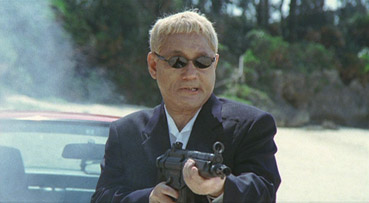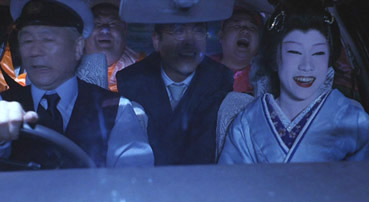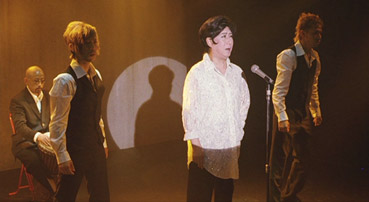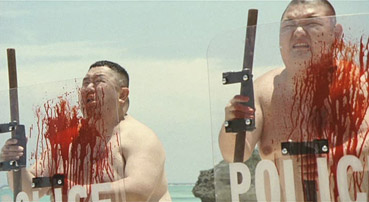|
It's an unfortunate side-effect of film economics that filmmakers tend to do their most personal and artistic work at the start of their film careers, on low-budget features that are not subject to the pressures of the market and the expectations of the public and studio financiers. All of this changes once you're in the system, which is why when E. Elias Merhige made Shadow of the Vampire, he was expected to deliver a coherent and engaging story rather than the mind-bending abstractions of his 1990 debut feature, Begotten. The earlier film may have convinced producer Nicholas Cage (yep, that one) that Merhige was a man of rare vision and talent, but it's not going to put more than a handful of bums on seats. At least not in this universe.
There are always exceptions. If that personal first film makes a big enough splash then its director may be allowed to continue in a similar vein on a higher budget, usually in the hope that a second lightning strike will reap financial and critical rewards for the studio. This doesn't happen that often because it frequently backfires. The free reign given to Darren Aronofsky following his cult hit 1998 hit Pi produced the glorious Requiem for a Dream, a critical favourite that nonetheless struggled to make back its $4.5 million budget. Then he made The Fountain, which despite its supporters was critically panned and a box-office dud. He's since bounced back with The Wrestler, a compellingly handled but more conventional drama, and the first of his films that he had no hand in writing.

Occasionally a filmmaker will achieve the sort of stature that allows them to make pretty much any film they want even late in their career. But there's a risk attached. Films cost time and money to make, usually a great deal of both, and those holding the purse strings have very short memories. Make no mistake, that run of big hits you made for the studio will soon be forgotten when you serve up a universally panned box-office flop. I'll just bet the studio bigwigs are queuing up to throw money at Richard Kelly after he followed the box-office poison of Southland Tales (which we rather liked, as it happens) with the critically mauled The Box.
Mid or late career artistic diversions are rarely good news for financial backers, but they can result in extraordinary films, two favourite examples being Kurosawa Akira's spellbinding Dreams (1990) and Orson Welles' glorious F for Fake (1973). Somewhat less common are those mid-career works in which a filmmaker appears as his or herself, a game-play with reality that invites accusations of self-indulgence and vanity stroking. Just recently, cult actor Bruce Campbell fell foul of this concept in his 2007 My Name is Bruce, but just occasionally even this risky strategy has born fruit, as with Wes Craven's 1994 New Nightmare, which inventively drew a line under the seemingly never-ending stream of Freddie Kruger films that Craven gave birth to in the first place.
There's no question that Kitano Takeshi is an artist of considerable international repute. Quite apart from his impressive body of work as a filmmaker, he's also an actor, a TV presenter, a published poet and novelist, a screenwriter, and an accomplished painter. In March of this year he was named a Commander of the Order of the Arts and Letters of France, the country's highest artistic honour. Not bad for a University drop-out who began life as a manzai comedian. His early films were distinctive and stylistically adventurous without sacrificing their commercial appeal, giving rise to works such as Boiling Point / 3-4 x jûgatsu (1990), Sonatine (1993) and Hana-Bi (1997), beautifully engineered yakuza stories that have found an appreciative audience far beyond their home shores. Even the autobiographical Kids Return (1996), the most personal of his early films, was a highly accessible and audience-friendly drama run through with the filmmaker's specific brand of character comedy. More recently his output has switched between commercially minded films like Zatōichi and artistically adventurous projects such as the 2002 Dolls.

Then in 2005 he wrote and directed Takeshis', in which he plays not just himself, but a quiet and unassuming wannabe actor with the same name and appearance who dreams of being him. Well that's not strictly true. What he actually dreams of is acting out the sort of tough guy yakuza roles for which his namesake has become famous. If this sounds self-indulgent then be sure that it is, but it's also enthralling, revealing, funny and surreal to the point of semi-abstraction.
There is a plot, at least for a while. Renowned actor and TV presenter Beat Takeshi is at work on his latest, Okinawa-set yakuza feature at the very same studio at which a shy and unassuming convenience store clerk named Mr. Kitano has landed a few days' work. The two briefly meet when Kitano asks Takeshi for his autograph – Takeshi remarks on their facial similarity and their shared surname, but neither he nor his busy PA seem to realise that, apart from Kitano's blond dyed hair, the two are visually identical. They're not the only ones. Despite Takeshi's face being plastered all over the city on posters for his new film, 'Hell Beat', almost no-one seems to notice the uncanny resemblance between the two men. The one exception is the polite young female stalker who stands outside Kitano's apartment and presents him with gifts in the belief that he is his more famous doppelganger. Kitano's ambitions to become an actor are repeatedly frustrated by his own shyness and a hostile and mischievous audition producer, and his efforts are loudly and repeatedly mocked by a slick-dressing yakuza neighbour and his shallow girlfriend. It's a mundane and lonely existence from which he escapes through increasingly violent daydreams in which he is cast as a gun-toting Takeshi in one of his yakuza roles.
Despite the stark social and professional gap between them, the lives of the two men are peppered with mirror images of the other, notably in the people they meet and regularly associate with. This casts almost every key player in the film in at least two roles, playing one person in Takeshi's world and another in Kitano's. Many of the actors are instantly recognisable Kitano regulars: Takeshi's friend and Kitano's mocking yakuza neighbour are both played by his close friend and associate Terajima Susumu (check almost any Kitano directed film and you'll find him there somewhere); the audition producer and mah-jong parlour woman are played by Kishimoto Kayako, who played Takeshi's wife in Hana-bi and Kikujirō, and Haruna's aunt in Dolls; Takeshi's manager and Kitano's taxi driver friend are played by Ōsugi Ren, who has appeared in a number of Kitano films and many key works of modern Japanese cinema, including Sonatine, Maborosi, Shall We Dansu?, Kids Return, Cure, Audition, Dead or Alive, Dolls, The Twilight Samurai and Nightmare Detective; and Watanabe Tetsu (Dreams, Sonatine, Mononoke Hime, Hana-bi, Memories of Matsuko) plays the triple role of TV wardrobe master, noodle cook, and audition actor. Familiar faces from earlier Kitano films also pepper the smaller roles, including Musaka Naomasu, Takeshige Tsutomu, Tsuda Kanji, Ashikawa Makoto, Kunimoto Shoken, and Kitano's former stand-up partner, Beat Kiyoshi. The popular star Asano Tadanobu (whose credits include Sōseiji, Gohatto, Zatōichi, Survive Style 5+, Mongol and Kenneth Brannagh's upcoming Thor) even makes an appearance, while celebrated and multi-talented drag queen Miwa Akihiro (who had a scene-stealing role in Fukusaku Kenji's Black Rose Mansion and provided key voice work for Miyazaki's Princess Mononoke and Howl's Moving Castle) appears as himself, to be initially mocked and later emerge from a giant caterpillar to perform a musical number accompanied by tap dance group The Stripes, who provided key support in Zatōichi.

It's also worth noting that the character of Takeshi, although directly modelled on Kitano the actor, director and media star, is essentially an alter-ego whose current projects appear to be based largely on past works from the director's actual oeuvre. So numerous are the references to his earlier films that that newcomers to his work are likely to find themselves completely at sea from an early stage. Spotting these references is certainly good fun and allows Kitano the writer-director to take a few short-cuts based on what he expects the audience to know – just how much this familiarity with his films helps clarify the narrative is hard to say, but it certainly gives you a head start during the increasingly disorientating reality shifts that follow.
While the daydreams are initially signposted, the melding of fantasy and reality steadily increases in complexity, to the point where even the image of Kitano waking from a dream state is an untrustworthy pointer. Employing an editing structure worthy of Orson Welles in F for Fake mode, Kitano the director and editor plays mind-bending games with the reality base and temporal structure of his story, as people encountered briefly by one character are imagined as their equivalents in the lives of the other, while seemingly disconnected inserts later prove to be flash-forward premonitions, sometimes of daydreams that have yet to be experienced or fully realised.
In this respect, Takeshis' unfolds like fractured memories flashing through their creator's head as he plummets of a cliff towards certain death, a broken-mirror recall of past film work, acquaintances, influences, experiences and anxieties, all so tightly interwoven that it's nigh-on impossible to identify which is which. The opening WW2 sequence is a case in point, where Takeshi casts himself as the sole survivor of a battle with American troops, regaining consciousness to find himself looking into the face, and later the gun, of an American soldier. Is this a recreation of a true story told to him by a family member, an expression of his own angst at international reaction to his work, or symbolic of the post-war American presence in Japan and the gradual and destructive Americanisation of Japanese culture? In the interview on the DVD, Takeshi leans towards the last of these, but does so with an offhand amusement that suggests the comment should not be taken too seriously.
As the mirror pieces scatter, it becomes increasingly hard to keep track of just what is going on or to assign specific meaning to anything you see or hear. Kitano himself has described the film as his first attempt at cubism, and that's as good a description of its structure as I've read, a fragmented psychological self-portrait in which Kitano explores his career, his anxieties and his self-imposed duality in sometimes confusing but often strikingly cinematic terms. Yet the film is considerably more fun than the above might suggest, with moments of surreal, almost Python-esque humour mixed with throwaway gags, and to far more engaging effect than his 1994 idiot comedy Getting Any? (Minnâ-yatteruka!). It's a shame that one my favourites – a restaurant menu that is actually a list of owner-dictated rules on how customers must behave** – is on screen for too short a time for subtitle translation.

Which just leaves the question of that enigmatic title and the placement of that apostrophe, an incomplete sentence that suggests the dual ownership of something that is pretty much left for the audience to figure out and disagree on, another enigma in a film that is positively riddled with them. By turns bemusing, enthralling, surreal and hilarious (Kitano's oddball taxi driving dream gets funnier as it progresses), it's a sometimes baffling but consistently fascinating deconstruction by an artist of his own persona that will mean little to anyone not familiar with the director's body of work, but acts a very personal and strangely satisfying palette cleanser for projects to come.
There have been some excellent transfers on Artificial Eye discs of late – picture quality on their Blu-ray release of Michael Haneke's The White Ribbon is genuinely stunning – but this is not one of them. An NTSC to PAL conversion, the transfer is certainly serviceable, and when the conditions are right, the picture is colourful and detailed, but the reasonable black levels you'll find in some scenes have a tendency to grey out in some of the darker sequences. For much of the time the colour has an earthy hue, and motion blurring is evident on fast object and camera movements. The exposure shifts in the TV studio and mah-jong parlour appear to have been deliberate and are also present on Panorama's earlier NTSC Hong Kong DVD release, where the picture quality is a little more consistent than it is here. The picture is also slightly windowboxed on all sides.
There's not a huge difference between the Dolby 2.0 stereo and 5.1 surround tracks – both are clear with some distinct separation and both are a touch lower in volume than the current DVD standard. Music sounds good on both tracks and especially so on 5.1, where the LFE bass gives the dance sequences a little extra punch.
Interview with Takeshi Kitano (15:48)
Spliced together from two interviews (how appropriate), Takeshi tends to confirm what you'll probably have guessed for yourself, that this is a very personal film, a consolidation of his work to date, and a blend of dreams, autobiography and fiction. He does talk about his collaboration with Miwa and The Stripes, about his need to provoke, and about the decision to dye his hair because of "the intrigue of the freak." He intriguingly describes the film as a cinematic UFO – "everyone says all sorts of things about it," he says, "but no-one can work out what it actually is."
Also included are trailers for Takeshis' (1:14), Zatoichi (1:22) and Dolls (1:34).
We've waited a long time for Takeshis' to reach the UK (I bought the Panorama disc over three years ago), so it's a bit of a shame that it's arrived as an NTSC to PAL conversion, albeit one without serious issues. For those unfamiliar with Kitano's work, this is no place to start, as you'll need to be well versed in his career and his cinema to even start making sense of what unfolds here, and even then you're likely to be scratching your head. Some will doubtless balk at the self-indulgence, and that's fair enough, but if you're up for the ride, it's genuinely unlike anything your likely to see this or any other year.
- Order only after making eye contact with the owner;
- Do not bring children into the restaurant;
- No talking;
- No mobile phones;
- Ten minutes maximum eating time;
- Do not wipe the table with a wet cloth after eating;
- You will be charged double if any food is left.
|